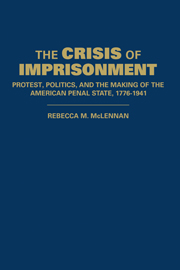Book contents
- Frontmatter
- Contents
- Acknowledgments
- Introduction: The Grounds of Legal Punishment
- 1 Strains of Servitude: Legal Punishment in the Early Republic
- 2 Due Convictions: Contractual Penal Servitude and Its Discontents, 1818–1865
- 3 Commerce upon the Throne: The Business of Imprisonment in Gilded Age America
- 4 Disciplining the State, Civilizing the Market: The Campaign to Abolish Contract Prison Labor
- 5 A Model Servitude: Prison Reform in the Early Progressive Era
- 6 Uses of the State: The Dialectics of Penal Reform in Early Progressive New York
- 7 American Bastille: Sing Sing and the Political Crisis of Imprisonment
- 8 Changing the Subject: The Metamorphosis of Prison Reform in the High Progressive Era
- 9 Laboratory of Social Justice: The New Penologists at Sing Sing, 1915–1917
- 10 Punishment without Labor: Toward the Modern Penal State
- Conclusion: On the Crises of Imprisonment
- Select Bibliography
- Index
8 - Changing the Subject: The Metamorphosis of Prison Reform in the High Progressive Era
Published online by Cambridge University Press: 18 August 2009
- Frontmatter
- Contents
- Acknowledgments
- Introduction: The Grounds of Legal Punishment
- 1 Strains of Servitude: Legal Punishment in the Early Republic
- 2 Due Convictions: Contractual Penal Servitude and Its Discontents, 1818–1865
- 3 Commerce upon the Throne: The Business of Imprisonment in Gilded Age America
- 4 Disciplining the State, Civilizing the Market: The Campaign to Abolish Contract Prison Labor
- 5 A Model Servitude: Prison Reform in the Early Progressive Era
- 6 Uses of the State: The Dialectics of Penal Reform in Early Progressive New York
- 7 American Bastille: Sing Sing and the Political Crisis of Imprisonment
- 8 Changing the Subject: The Metamorphosis of Prison Reform in the High Progressive Era
- 9 Laboratory of Social Justice: The New Penologists at Sing Sing, 1915–1917
- 10 Punishment without Labor: Toward the Modern Penal State
- Conclusion: On the Crises of Imprisonment
- Select Bibliography
- Index
Summary
Our principal trouble in prison reform is that reforms have been patchwork. The time has come, it seems to me, for thorough-going studies followed by thorough-going reform.
Theodore Roosevelt, “The New Penology” (1913)In the fall of 1913, the defenders of progressive statecraft engineered a remarkable opportunity to reverse their losses and advance their cause when an ordinary laborer by the name of Tom Brown was committed to the New York State Prison at Auburn. On its face, Brown's incarceration was routine: Upon entering the administration building, he was allocated a prisoner number – #33,333X – which the Prison Clerk recorded, together with details of his conviction, in the prison Admissions Ledger. Brown then answered questions put to him by one of the prison medical orderlies. The orderly noted on an index card that the new prisoner was a widower, laborer, and father of four, with a high school education. Prison officials then prepared Brown's person for incarceration: A convict–barber trimmed his hair and shaved off his thick moustache, an office clerk took his finger prints, and the Bertillon clerk examined, photographed, and measured his body, noting that the new prisoner's distinguishing features included a large scar and six small tattoos on his left bicep. Brown then exchanged his civilian attire for prison shoes, underwear, and the standard-issue coarse gray uniform.
- Type
- Chapter
- Information
- The Crisis of ImprisonmentProtest, Politics, and the Making of the American Penal State, 1776–1941, pp. 319 - 375Publisher: Cambridge University PressPrint publication year: 2008



